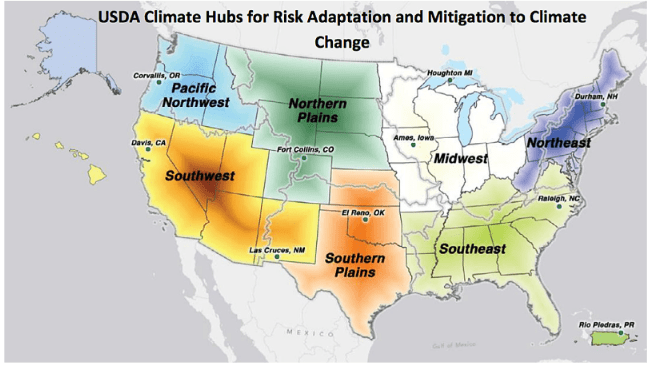Weather and Technological Change’s Impact on Total Factor Productivity
 Reviewer
Reviewer
David J. Williams, Graduate Research Assistant
Article
The Sources of Measured U.S. Agricultural Productivity Growth: Weather, Technological Change, and Adaptation. Robert G. Chambers and Simone Pieralli
Journal
American Journal of Agricultural Economics, May 2020, Vol. 102, No. 4, Pages 1198-1226
Summary
Total factor productivity (TFP) is a measure of economic efficiency and is commonly measured as the ratio of outputs to inputs. The higher the TFP, the more product is created for a given level of inputs. For farmers, this means that the higher their TFP, the higher their yield will be for the same levels of acreage, fertilizers, insecticides, labor, machinery, etc. This article aims to explain changes in total factor productivity growth of the agricultural sector by attributing it to weather, as well as technological change and adaptation.
The authors use mathematical programming techniques on state level data for aggregate inputs and outputs of agricultural products in order to calculate the efficiency of a given state each year. At the same time, the authors are able to calculate the most efficient possible combinations of inputs for given levels of outputs in a given year. This is known as the “best-attainable agricultural production frontier”. Every year, each state is given an efficiency rating from 0 to 1, where 1 is the most efficient possible and would indicate that the farmers in that state are operating on the productivity frontier. Technological change is what moves the frontier, and the speed at which farmers move toward the new frontier after it has moved is referred to as adaptation.
The authors find that weather has a small but important impact on productivity growth, which is counter to previous findings. Liang et al. (2017) found that 70% of the variation in productivity growth can be attributed to weather over the 1981-2010 period, and that weather has had an increasing effect compared to earlier periods. By accounting for the random nature of farming, the authors of this study found a much smaller, but still noticeable, effect of weather.
Differences in productivity growth across states and climate regions can be seen. The Pacific Northwest and the Midwest displayed the highest rates of productivity growth, while the Southern and Northern Plains displayed the lowest. The productivity growth of the Pacific Northwest region is attributed to very quick adaptation to new technologies compared to other regions. The Midwest’s higher productivity growth is attributed to higher levels of technological advancement compared to other regions. On the other hand, the lower productivity growth rates of the Northern and Southern Plains are attributed to slower rates of adaption to new technologies.
What this means for Food and Agricultural Business
Technological advancement is the key driver of productivity growth, and further innovation will be needed to continue to drive future growth. As weather and technological change is out of farmers’ control, the findings of this study indicate that farmers trying to increase their productivity should focus on adapting their farming methods to advancements in technology. Farmers located in the Northern or Southern Plains regions may be especially keen to better adapt to new technologies so that their productivity growth may better compete with that of other regions.

USDA Regional Hubs for Risk Adaptation and Mitigation to Climate Change available at https://www.usda.gov/oce/climate_change/hubs/USDAHubsFactsheet.pdf, accessed on 18th of September 2020.

Average efficiency scores by state – Chambers and Pieralli (2020)
RELATED POSTS:
Optimizing Sales Management: Knowledge, Coaching and Continuous Improvement
While we used to think that exceptional salespeople possessed an innate gift, recent data suggests the impact of today’s sales managers in nurturing and refining this gift to unlock its fullest potential.
A great moment for value-based sales in agribusiness
Value-based sales can empower companies to craft compelling value propositions, understand the customer’s business model and effectively communicate to stakeholders.
How can big data empower the development of new products?
Data is one of the most powerful resources for a company. It enables accurate decision-making and minimizes risk, ensuring greater revenue and sustainable growth.
